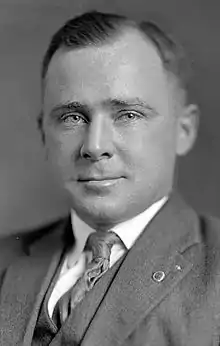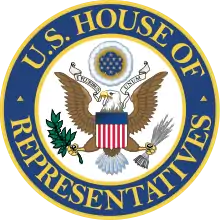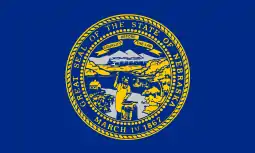Robert G. Simmons
Robert Glenmore Simmons (December 25, 1891 – December 27, 1969) was a Nebraska Republican politician.
Robert Glenmore Simmons | |
|---|---|
 | |
| 23rd Chief Justice of Nebraska | |
| In office 1939–1963 | |
| Preceded by | Charles A. Goss |
| Succeeded by | Paul W. White |
| Member of the U.S. House of Representatives from Nebraska's 6th district | |
| In office March 4, 1923 – March 3, 1933 | |
| Preceded by | Augustin Humphrey |
| Succeeded by | Constituency abolished |
| Personal details | |
| Born | December 25, 1891 Scottsbluff, Nebraska, U.S. |
| Died | December 27, 1969 (aged 78) Lincoln, Nebraska, U.S. |
| Political party | Republican |
| Alma mater | Hastings College University of Nebraska–Lincoln |
Simmons was born on December 25, 1891 near Scottsbluff, Nebraska. He attended Hastings College from 1909 to 1911 and the University of Nebraska–Lincoln in 1915. He was admitted to the bar in 1915 and set up practice in Gering, Nebraska. He was elected prosecuting attorney of Scotts Bluff County in 1916. During the first World War, on October 15, 1917, he enlisted in the army. He was commissioned as a second lieutenant in the Air Service on March 12, 1918 and was discharged on January 14, 1919.
Simmons was elected as a Republican to the 68th through 72nd Congresses (March 4, 1923 – March 3, 1933) to represent Nebraska's 6th district. When Nebraska lost a district, he ran and lost in the preceding new district in 1932. He ran for the United States Senate in 1934 against Edward R. Burke and in 1936 against George W. Norris, losing both times. He resumed practicing law in Lincoln, Nebraska.
Simmons was elected chief justice of the Supreme Court of Nebraska in 1938. He was also a deputy judge in the administrative tribunal of the International Labour Organization in Geneva, Switzerland, in 1955. While serving as Chief Justice, along with the chief justices of New Jersey, Arthur T. Vanderbilt, and Missouri, Laurance M. Hyde, he co-founded the Conference of Chief Justices in 1949. He retired in January 1963 after twenty-four years as the chief justice of Nebraska.
He returned to private law in Lincoln, Nebraska. He died in Lincoln on December 27, 1969 and is interred in Fairview Cemetery, Scottsbluff.
He was a Congregationalist, a member of the American Bar Association, a member of the Order of the Coif, a member of the American Legion, a Freemason and a Shriner.
References
- "Simmons, Robert Glenmore". The Political Graveyard. Retrieved January 14, 2006.
- "Simmons, Robert Glenmore". Biographical Directory of the United States Congress. Retrieved January 14, 2006.
- This article incorporates facts obtained from: Lawrence Kestenbaum, The Political Graveyard
 This article incorporates public domain material from the Biographical Directory of the United States Congress website http://bioguide.congress.gov.
This article incorporates public domain material from the Biographical Directory of the United States Congress website http://bioguide.congress.gov.- http://ccj.ncsc.dni.us
| U.S. House of Representatives | ||
|---|---|---|
| Preceded by Augustin Reed Humphrey |
Member of the U.S. House of Representatives from Nebraska's 6th congressional district March 4, 1923 – March 3, 1933 |
Succeeded by District abolished |
| Political offices | ||
| Preceded by Charles A. Goss |
Chief Justice of the Nebraska Supreme Court 1939–1963 |
Succeeded by Paul W. White |
| Party political offices | ||
| Preceded by J.H. Kemp |
Republican nominee for U.S. Senator from Nebraska (Class 1) 1934 |
Succeeded by Hugh Butler |
| Preceded by George W. Norris |
Republican nominee for U.S. Senator from Nebraska (Class 2) 1936 |
Succeeded by Kenneth S. Wherry |

